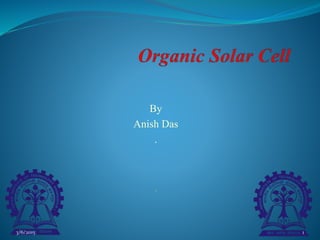Organic solar cell
- 2. ïķ Conductive nature of organic semiconductor. ïķ Source of free electron in organic materials. ïķ charge carriers in organic semiconductor. ïķ Basic mechanism of organic solar cell operation. 3/6/2015 2
- 3. ï At early days organics materials are widely used as insulating materials specially at semiconductor industry. ï Alan Heeger was the 1st person to propose that under certain circumstances organic materials can act as conducting materials. ï And the condition in congutaed polymer, i.e. alternating double and single bonds. Simplest exam is poly acetylene. It is available in trans and sis form. ï trans form is very conductive like silvery powder, more conductive than Si. 3/6/2015 3
- 4. The source of free electron in polymer is the Ï bond electron, which is loosely bound due to the lateral overlap of electron orbitals and is perpendicular to the sigma bond. Sigma bond is strong bond cause covalencey is there. 3/6/2015 4
- 5. The different types of carriers in organics materials are. 1. Excitons 2. Solitons 3. polarons 3/6/2015 5
- 6. ïą An excitonis an excited quasiparticle in a solid, which is formed by a Coulomb-bound electron-hole pair. ïą It is more prominent in organic semiconductors as compared to their inorganic counterparts: as the dielectric constant is lower in organics 3/6/2015 6
- 7. Soliton is a structural distortion in organic materials and forms when two single bonds meet. Single bonds moves through out the polymer chain, i.e. soliton wave propagates, i.e electron is propagating through out the chain give rise to the current. 3/6/2015 7
- 8. ïž Polaron is the coupling of electron/hole is the lattice. ïž Because organic materials does not have prominent periodicity like wise in crystal. So the charge carriers see potential difference at bound with the lattice. 3/6/2015 8
- 9. Use a blend of acceptor(fullerene) and donor(conjugated polymer). Light absorption in donor and stable exciton generation. Exciton diffusion/ Polaron production. Polaron pair dissociation and free ðâ -â+ pairs generation. Charge transport and get current. 3/6/2015 9
- 10. Here we are using two kind of materials. One is donor to produce exciton and acceptor dissociate exciton attract electrons. Itâs a kind of interfacing device. 3/6/2015 10
- 11. As stated above that light is absorbed by donor material or conjugated polymer & exciton is generated. This exciton is stable due to low K and high binding energy. 3/6/2015 11
- 12. Excitons are electrically neutral so it will come to the interface of donor and acceptor by only diffusion and see different potential or atmosphere, known as exciplex Exciplex 3/6/2015 12
- 13. At the interface of donor and acceptor materials the exciplex will see different atmosphere i.e. different potential i.e exciplex will feel potential difference. Then the electron will be drifted to the acceptor lattice and hole to the donor latttice i.e. exciplex dissociation occurs. And forms polarons pairs. These pair is still in coulomb bound. 3/6/2015 13
- 14. Polaron pairs formed at the acceptor and donor lattice is still in coulomb attraction. So we have to apply external voltage to dissociate them. This is one of the draw back of organic solar cell. 3/6/2015 14
- 15. As the polaron pairs are separated by applipled volrage then they will move towards the metal electrods by hopping transport. Hopping transport is very slow and depends on ðļ2âðļ1 ð . E1 E2 3/6/2015 15
- 17. Ready to illuminate your purpose. 3/6/2015 17
- 18. 3/6/2015 18
- 19. 3/6/2015 19



















